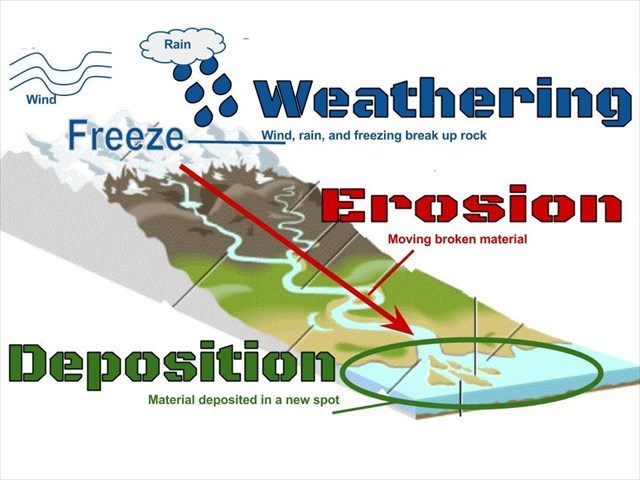

WEATHERING is the breaking down of rocks, soil, and minerals as well as wood and artificial materials through contact with the Earth's atmosphere, waters, and biological organisms. Weathering occurs in situ (on site), that is, in the same place, with little or no movement, and thus should not be confused with erosion, which involves the movement of rocks and minerals by agents such as water, ice, snow, wind, waves and gravity and then being transported and deposited in other locations (see below).
Two important classifications of weathering processes exist – physical and chemical weathering; each sometimes involves a biological component. Mechanical or physical weathering involves the breakdown of rocks and soils through direct contact with atmospheric conditions, such as heat, water, ice and pressure. The second classification, chemical weathering, involves the direct effect of atmospheric chemicals or biologically produced chemicals also known as biological weathering in the breakdown of rocks, soils and minerals. While physical weathering is accentuated in very cold or very dry environments, chemical reactions are most intense where the climate is wet and hot. (SOURCE)

In earth science, EROSION is the action of surface processes (such as water flow or wind) that remove soil, rock, or dissolved material from one location on the Earth's crust, and then transport it away to another location. The particulate breakdown of rock or soil into clastic sediment is referred to as physical or mechanical erosion; this contrasts with chemical erosion, where soil or rock material is removed from an area by its dissolving into a solvent (typically water), followed by the flow away of that solution. Eroded sediment or solutes may be transported just a few millimetres, or for thousands of kilometres. (SOURCE)
This video is particularly interesting.
In very SIMPLE terms, Weathering is the action of breaking down the rock and Erosion is the action of removal of the rock.
With this in mind, at the coordinates of this cache you have a set of greenish rocks. To qualify for a found, you need to tell me:
- Are these rocks weathered or eroded? Why?
- If you have decided that they are weathered, by what mechanism have they been weathered? – (Physical or chemical?)
- If you have decided that they are eroded, by what mechanism have they been eroded? – (physical / mechanical erosion or chemical erosion?)
- Choose the biggest “egg” and measure, in cm, the total amount of rock (in terms of depth) that is no longer there.

If you think you know all the answers, please log your found but send me, through my profile, the answers (*). If they are correct, you will not hear from me again but know that I truly appreciate you taking the time to visit this corner of the planet and I hope that you have learnt a little bit more about the geological processes that take place on the surface of the earth. If they’re wrong I will send you an explanatory note showing you where you went wrong. If you don’t send the answers, your log will be deleted without any explanation.

(*) Please note that when you e-mail me, please supply the reference (GC7DZB5) and name (Weathering vs. Erosion - DP/EC one-o-two) of the cache and please click on the “I want to send my e-mail address along with this message” so that when I reply to you the messages don’t go into e-mail heaven (or hell).

Meteorização ou intemperismo é o processo natural de decomposição ou desintegração de rochas e solos, e seus minerais constituintes, por ação dos efeitos químicos, físicos e biológicos que resultam da sua exposição aos agentes externos (neles se incluindo os factores antropogénicos, isto é devido direta ou indiretamente à ação humana ou natural). Em resumo, a meteorização é o fenómeno natural a que estão sujeitos todos os materiais geológicos quando expostos à ação combinada da atmosfera, da hidrosfera, da biosfera e da antroposfera, ocorrendo de forma permanente e generalizada em toda a superfície terrestre, não devendo contudo ser confundida com os efeitos da erosão, embora tenha frequentemente com eles uma relação estreita de causa e efeito.
Tipos de meteorização
Física: ocorre devido à variação de temperatura nas rochas, sendo mais típico em climas secos, sejam eles quentes ou frios. No calor as moléculas da rocha se expandem e no frio se contraem que ao longo dos anos causa uma rachadura na rocha. Além de tudo, os minerais que compõe as rochas têm diferentes coeficientes de dilatação, ampliando assim a fragmentação das rochas.
A cor e a granulometria da rocha influenciam a sua fragmentação, assim rochas mais escuras tendem a aquecer com mais facilidade, e as rochas mais grosseiras tendem a se desintegrar.
Química: ocorre devido a vários fatores como a cristalização de água em fraturas que provoca o aumento do volume em fissuras de rochas e de minerais.
Oxidação: consiste na mudança do estado de oxidação de um elemento, através de reacção com o oxigénio. Essa reação destrói a estrutura do mineral.
Dissolução: consiste da solubilização completa de alguns minerais por ácidos. (Adaptado de FONTE)
Erosão é a ação de processos superficiais, (tal como a ação do fluxo de água ou vento) que remove solo, rochas, ou material dissolvido de um local na crosta da Terra, que então o transporta para outro local. A ruptura de partículas provenientes de rocha e solo em sedimento clástico é denominado como erosão física ou mecânica; isso contrasta com a erosão química, onde o solo ou material de rocha é removido através da dissolução, promovido por um solvente (tipicamente água), seguido pelo fluxo da solução. Os sedimentos ou solutos erodidos podem ser transportados apenas por alguns milímetros ou para milhares de quilômetros. (FONTE)
Este vídeo é particularmente interessante.
Em termos muito SIMPLES, Meteorização é a ação de quebrar a rocha e Erosão é a ação de remoção da rocha.

Com isso em mente, nas coordenadas deste cache tens um conjunto de rochas esverdeadas. Para validar mais um FOUND IT, responde às seguintes perguntas:
1- Essas rochas estão meteorizadas ou erodidas? Porquê?
2- Se decidiste que estão meteorizadas, por qual mecanismo eles foram meteorizadas? - (físico ou químico?)
3- Se você decidiu que eles estão erodidas, por qual mecanismo eles foram erodidas? - (erosão física / mecânica ou erosão química?)
4- Escolhe o maior "ovo" e mede, em cm, a quantidade total de rocha (em termos de profundidade) que já não existe mais.
Se achas que sabes todas as respostas, por favor faz o teu log de “found”, mas ao mesmo tempo envia-me as respostas a estas perguntas (* - ver em cima).
Se estiverem correctas, não respondo mas fica sabendo que eu estimo a tua visita a este cantinho do planeta e espero que esta cache sirva para desvendar mais um mistério dos processos geológicos da nossa bola azul. Se estiveram erradas, vais a exame novamente e levas com TPC’s extras. Porém se não enviares as respostas, simplesmente apago o log.

 The most exciting way to learn about the Earth and its processes is to get into the outdoors and experience it first-hand. Visiting an Earthcache is a great outdoor activity the whole family can enjoy. An Earthcache is a special place that people can visit to learn about a unique geoscience feature or aspect of our Earth. Earthcaches include a set of educational notes and the details about where to find the location (latitude and longitude). Visitors to Earthcaches can see how our planet has been shaped by geological processes, how we manage the resources and how scientists gather evidence to learn about the Earth. To find out more click HERE.
The most exciting way to learn about the Earth and its processes is to get into the outdoors and experience it first-hand. Visiting an Earthcache is a great outdoor activity the whole family can enjoy. An Earthcache is a special place that people can visit to learn about a unique geoscience feature or aspect of our Earth. Earthcaches include a set of educational notes and the details about where to find the location (latitude and longitude). Visitors to Earthcaches can see how our planet has been shaped by geological processes, how we manage the resources and how scientists gather evidence to learn about the Earth. To find out more click HERE.